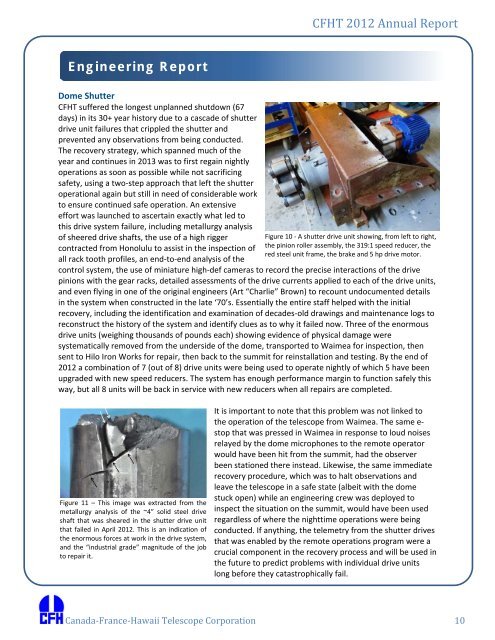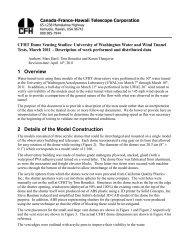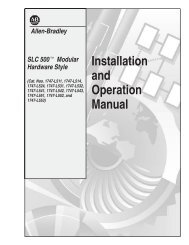2012 CFHT Annual Report - Canada France Hawaii Telescope ...
2012 CFHT Annual Report - Canada France Hawaii Telescope ...
2012 CFHT Annual Report - Canada France Hawaii Telescope ...
You also want an ePaper? Increase the reach of your titles
YUMPU automatically turns print PDFs into web optimized ePapers that Google loves.
<strong>CFHT</strong> <strong>2012</strong> <strong>Annual</strong> <strong>Report</strong><br />
Engineering <strong>Report</strong><br />
Dome Shutter<br />
<strong>CFHT</strong> suffered the longest unplanned shutdown (67<br />
days) in its 30+ year history due to a cascade of shutter<br />
drive unit failures that crippled the shutter and<br />
prevented any observations from being conducted.<br />
The recovery strategy, which spanned much of the<br />
year and continues in 2013 was to first regain nightly<br />
operations as soon as possible while not sacrificing<br />
safety, using a two‐step approach that left the shutter<br />
operational again but still in need of considerable work<br />
to ensure continued safe operation. An extensive<br />
effort was launched to ascertain exactly what led to<br />
this drive system failure, including metallurgy analysis<br />
of sheered drive shafts, the use of a high rigger<br />
contracted from Honolulu to assist in the inspection of<br />
all rack tooth profiles, an end‐to‐end analysis of the<br />
Figure 10 ‐ A shutter drive unit showing, from left to right,<br />
the pinion roller assembly, the 319:1 speed reducer, the<br />
red steel unit frame, the brake and 5 hp drive motor.<br />
control system, the use of miniature high‐def cameras to record the precise interactions of the drive<br />
pinions with the gear racks, detailed assessments of the drive currents applied to each of the drive units,<br />
and even flying in one of the original engineers (Art “Charlie” Brown) to recount undocumented details<br />
in the system when constructed in the late ‘70’s. Essentially the entire staff helped with the initial<br />
recovery, including the identification and examination of decades‐old drawings and maintenance logs to<br />
reconstruct the history of the system and identify clues as to why it failed now. Three of the enormous<br />
drive units (weighing thousands of pounds each) showing evidence of physical damage were<br />
systematically removed from the underside of the dome, transported to Waimea for inspection, then<br />
sent to Hilo Iron Works for repair, then back to the summit for reinstallation and testing. By the end of<br />
<strong>2012</strong> a combination of 7 (out of 8) drive units were being used to operate nightly of which 5 have been<br />
upgraded with new speed reducers. The system has enough performance margin to function safely this<br />
way, but all 8 units will be back in service with new reducers when all repairs are completed.<br />
Figure 11 – This image was extracted from the<br />
metallurgy analysis of the ~4” solid steel drive<br />
shaft that was sheared in the shutter drive unit<br />
that failed in April <strong>2012</strong>. This is an indication of<br />
the enormous forces at work in the drive system,<br />
and the “industrial grade” magnitude of the job<br />
to repair it.<br />
It is important to note that this problem was not linked to<br />
the operation of the telescope from Waimea. The same e‐<br />
stop that was pressed in Waimea in response to loud noises<br />
relayed by the dome microphones to the remote operator<br />
would have been hit from the summit, had the observer<br />
been stationed there instead. Likewise, the same immediate<br />
recovery procedure, which was to halt observations and<br />
leave the telescope in a safe state (albeit with the dome<br />
stuck open) while an engineering crew was deployed to<br />
inspect the situation on the summit, would have been used<br />
regardless of where the nighttime operations were being<br />
conducted. If anything, the telemetry from the shutter drives<br />
that was enabled by the remote operations program were a<br />
crucial component in the recovery process and will be used in<br />
the future to predict problems with individual drive units<br />
long before they catastrophically fail.<br />
<strong>Canada</strong>‐<strong>France</strong>‐<strong>Hawaii</strong> <strong>Telescope</strong> Corporation 10




![Documentation [PDF] - Canada France Hawaii Telescope ...](https://img.yumpu.com/26965302/1/190x245/documentation-pdf-canada-france-hawaii-telescope-.jpg?quality=85)







